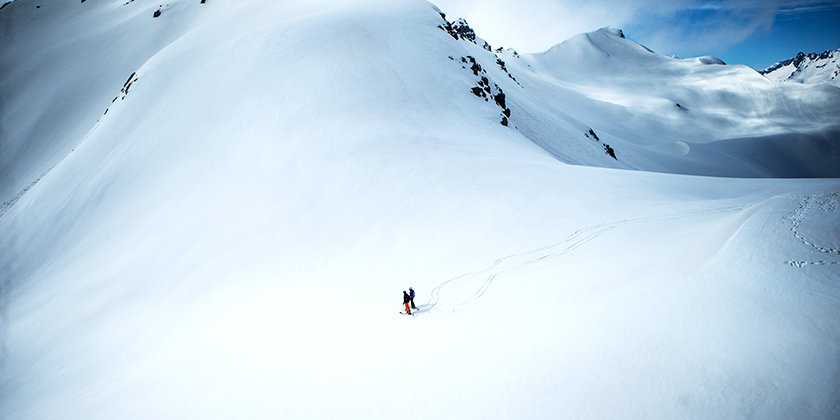.jpg/_jcr_content/renditions/cq5dam.web.320.320.jpeg)
The Lifesaving Innovation for Backcountry Adventurers
Once you begin taking on more extreme and remote terrain, it’s definitely worth investing in an airbag system; there are several systems available and they all work on similar principles. The pack houses an airbag that can be inflated in the event of an avalanche by pulling an activation handle. During an avalanche, objects with a higher volume will rise towards the surface; the inflation of the airbag increases your volume, helping to keep you as high as possible within the snow structure, increasing your chance of survival.
What Is an Avalanche Airbag and How Does It Work?
An avalanche airbag is a specialised safety device integrated into a backpack, designed to increase your chances of survival if you are caught in an avalanche. The core principle behind its operation is simple yet profoundly effective: by increasing your body volume during an avalanche, the airbag helps you stay closer to the surface of the moving snow. This is achieved by rapidly inflating one or more airbags at the pull of a handle or ripcord, usually within three seconds of activation. The inflation process is powered either by a pressurised gas cylinder or, in more recent models, by a battery-operated fan. The larger surface area created by the inflated airbag leverages the natural physics of avalanches, where larger objects tend to rise to the top while smaller ones sink—a phenomenon known as inverse segregation or the “Brazil Nut Effect.” This principle is what makes avalanche airbags so effective in real-life scenarios.
In practical terms, when an avalanche starts, the snow behaves much like a fluid, with particles of different sizes moving and settling at different rates. By increasing your volume, the airbag makes you the “larger object” in the mix, thereby increasing the likelihood that you will remain on or near the surface as the avalanche comes to rest. This is crucial because the majority of avalanche fatalities are caused by asphyxiation due to burial, and being closer to the surface dramatically increases your chances of being found and rescued quickly.

Types of Avalanche Airbag Systems: Mechanical vs. Electric
There are two primary types of avalanche airbag systems available on the market today: mechanical and electric. Each has its own set of advantages and considerations, and the choice between them depends on your specific needs and preferences.
Mechanical Airbag Systems
Mechanical avalanche airbag systems rely on a pressurised gas cylinder to inflate the airbag when the handle is pulled. These systems are known for their reliability and simplicity. They are lightweight and have been proven in the field for many years. However, one drawback is the need to replace the gas cylinder after each deployment, and there can be restrictions on transporting pressurised cylinders on aeroplanes, which may complicate travel for international adventures.
Electric Airbag Systems
Electric avalanche airbag systems, on the other hand, use a battery-powered fan or compressor to inflate the airbag. These systems can be used multiple times without the need to replace a gas cylinder, making them more convenient for frequent travellers or those who want to practise deploying the airbag without incurring additional costs. Electric systems are generally heavier and more expensive than their mechanical counterparts, but the convenience and flexibility they offer make them an attractive option for many backcountry enthusiasts.
Innovations and Advancements in Avalanche Airbag Technology
Avalanche airbags have evolved dramatically since their introduction in the 1980s. Early models used a single rear airbag, but modern systems often feature twin airbags for greater stability and protection. Recent innovations include:
- Wireless Activation: Some systems allow group members to trigger each other’s airbags remotely, adding an extra layer of safety for travel companions.
- Automatic Deflation: Advanced airbags can automatically deflate after deployment, creating an air pocket around your face that may further increase survival chances in a full burial.
- Integrated Protection: Some designs offer additional protection for the head, neck, and chest, reducing the risk of trauma during an avalanche.
- Battery-Powered Inflation: Brands like Arc’teryx have introduced airbags that use electric blowers instead of gas cylinders, making them more convenient for international travel and repeated use.
How to Choose the Right Avalanche Airbag
Selecting the right avalanche airbag is a crucial decision that depends on a variety of factors, including your typical activities, travel plans, and personal preferences. When evaluating different systems, it is important to consider the type of inflation mechanism—mechanical or electric—as well as the size and weight of the backpack. The capacity of the pack should match your gear requirements for the duration of your trips, and the weight of the system should be comfortable for you to carry over long distances.
Additional features to look for include ease of maintenance, the availability of replacement parts, and any extra safety features such as wireless activation or integrated protection. Price is also an important consideration, as avalanche airbags can represent a significant investment. However, given the potential lifesaving benefits, many backcountry travellers consider this a worthwhile expense.
It is also worth noting that avalanche airbags are not a substitute for proper training and avalanche awareness. They should be used as part of a comprehensive safety strategy that includes carrying a transceiver, shovel, and probe, as well as staying informed about current avalanche conditions and practising safe travel techniques.

The Future of Avalanche Airbag Innovation
The future of avalanche airbag technology looks bright, with ongoing research and development aimed at making these systems even more effective, user-friendly, and integrated with other safety technologies. As more people venture into the backcountry, the demand for reliable, innovative safety gear will continue to grow.
Expect to see further integration with digital devices, such as smartphones and smartwatches, for real-time safety monitoring and communication. Improved battery life for electric systems, smarter group safety features, and even more robust materials for enhanced protection are all likely to be part of the next generation of avalanche airbags.
Ultimately, the goal is to make backcountry travel as safe as possible, giving adventurers the confidence to explore the mountains while knowing they have the best possible protection against one of nature’s most unpredictable hazards.
Why Avalanche Airbags Are Essential for Winter Mountain Safety
Avalanche airbags have become the fourth essential piece of safety equipment for backcountry travel, alongside the avalanche transceiver, shovel, and probe. While no piece of gear can guarantee survival in every situation, avalanche airbags significantly increase your chances of making it home safely after an incident. Investing in a quality airbag system—and learning how to use it properly—is one of the best decisions you can make for your safety in the mountains.
By staying informed about the latest innovations and choosing the right system for your needs, you can enjoy the freedom and adventure of the backcountry with greater peace of mind. For expert advice, top brands, and the best selection of avalanche airbags and safety gear, visit Snow+Rock and equip yourself for your next winter adventure.
FAQs
Avalanche airbags have been shown to reduce the risk of death in certain scenarios by up to 50%. Their effectiveness depends on a number of factors, including the terrain, the timing of deployment, and the presence of obstacles such as trees or rocks. They are most effective when deployed early in the avalanche and in open terrain.
To deploy your avalanche airbag, simply pull the handle or ripcord as soon as you suspect you are caught in an avalanche. The airbag will inflate automatically, increasing your volume and helping you stay near the surface of the moving snow.
Mechanical systems that use pressurised gas cylinders may be subject to restrictions when travelling by air. Electric systems, which use battery-powered fans, are generally easier to transport and do not have the same restrictions as gas cylinders.
The airbag is only effective if deployed while the avalanche is in motion. Once the snow has settled, the airbag will not help you rise to the surface. This is why it is crucial to act quickly and decisively in an emergency situation.
Regular maintenance is essential to ensure that your avalanche airbag is ready when you need it. Follow the manufacturer’s guidelines for inspection and servicing, and check your system before each trip to the mountains.
Related Articles

Let us know you agree to cookies
We use marketing, analytical and functional cookies as well as similar technologies to give you the best experience. Third parties, including social media platforms, often place tracking cookies on our site to show you personalised adverts outside of our website.
We store your cookie preferences for two years and you can edit your preferences via ‘manage cookies’ or through the cookie policy at the bottom of every page. For more information, please see our cookie policy.



